Triplanetary with miniatures
The playing surface
The second edition Triplanetary map is 35 x 51 hexes, short-grained (i.e., the rows are parallel to the short side of the map).
We used two Hotz maps, with 1.5 in across hexes. These have are long grained, 72 in x 45 in.
By using two mats we get an area 48 hex x 69 hex, taking up a table 72 in x 90 in.
We used our existing blue and green mats; black would be better!
We used two Hotz maps, with 1.5 in across hexes. These have are long grained, 72 in x 45 in.
By using two mats we get an area 48 hex x 69 hex, taking up a table 72 in x 90 in.
We used our existing blue and green mats; black would be better!
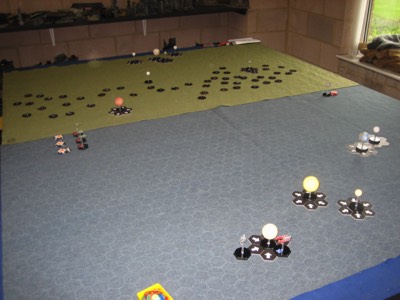
Two Hotz mats, prior to a game of Triplanetary. Sol is in the right foreground, Jupiter centre back. The black items are gravity hexes round planets, and asteroids.
Planets
Planets are made from West Design Kids Craft polystyrene balls. These come with 40 balls of assorted sizes; I found two packs had a sufficient range of sizes for the game.
I used the following sizes:
Sol 47 mm
Jupiter 42 mm
Terra 39 mm
Venus 39 mm
Mars 39 mm
Ganymede 25 mm
Mercury 25 mm
Callisto 20 mm
Io 20 mm
Luna 20 mm
Europa 15 mm
Ceres 10 mm
Clandestine 10 mm
Information: http://en.wikipedia.org/wiki/List_of_Solar_System_objects_by_size
I mounted these on our usual AERONAUTICA IMPERIALIS FLYING BASES from www.forgeworld.co.uk. I glued strong magnets glued to their tops and applied magnetic sheet to the bottom side of their bases.
I pushed short flat headed nails into the smaller planets, so they would mount on the top of the base poles, and bored holes into the larger planets to insert the poles into..
Planets were painted with matt acrylic paints, with the sea sections of Terra and the whole of Sol given a coat of gloss varnish (I finished off Terra by dry brushing with some white clouds).
I printed the gravity hexes on adhesive label material, then applied these to stiff card and trimmed them to size. A small patch of steel paper in the centre hexes helps hold the planet's base in place.
I used the following sizes:
Sol 47 mm
Jupiter 42 mm
Terra 39 mm
Venus 39 mm
Mars 39 mm
Ganymede 25 mm
Mercury 25 mm
Callisto 20 mm
Io 20 mm
Luna 20 mm
Europa 15 mm
Ceres 10 mm
Clandestine 10 mm
Information: http://en.wikipedia.org/wiki/List_of_Solar_System_objects_by_size
I mounted these on our usual AERONAUTICA IMPERIALIS FLYING BASES from www.forgeworld.co.uk. I glued strong magnets glued to their tops and applied magnetic sheet to the bottom side of their bases.
I pushed short flat headed nails into the smaller planets, so they would mount on the top of the base poles, and bored holes into the larger planets to insert the poles into..
Planets were painted with matt acrylic paints, with the sea sections of Terra and the whole of Sol given a coat of gloss varnish (I finished off Terra by dry brushing with some white clouds).
I printed the gravity hexes on adhesive label material, then applied these to stiff card and trimmed them to size. A small patch of steel paper in the centre hexes helps hold the planet's base in place.
Asteroids
I used a hot glue gun to stick cat litter to Litko hexagonal wooden bases. These were then sprayed black, the litter painted grey, and then given a thin black ink wash on the litter to give it some depth.
Playing aids
We used 10 mm diameter plastic counters to plot ship paths, noting fuel and weapon expenditure on paper. I was worried the counters would be accidentally moved during the game, but they worked well.
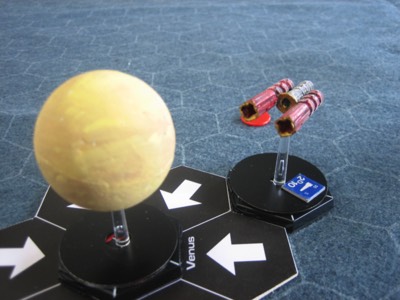
Venus. The dial displays of the IMPERIALIS base are not needed, so they are obscured by black painted steel "washers".
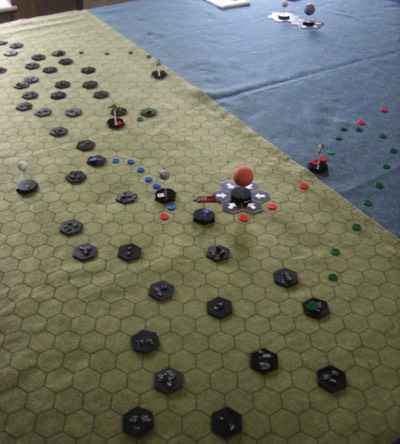
Mars and the asteroid belt, with Ceres on the left, Terra and Luna in the distance.
Note the counters marking previous path and predicted next inertial (non-boost) move of liner (red), Navy (blue), and pirates (green).
Note the counters marking previous path and predicted next inertial (non-boost) move of liner (red), Navy (blue), and pirates (green).
Spaceships
I wanted these to be inexpensive and in keeping with the feel of Triplanetary (i.e. older "traditional" designs, more like '2001' than 'Star Trek'/'Star Wars'). I couldn't find any suitable commercial models, so decided to make my own.
Painting on the ships was kept minima; simple colours, followed by a black ink wash and then dry brushing.
Painting on the ships was kept minima; simple colours, followed by a black ink wash and then dry brushing.
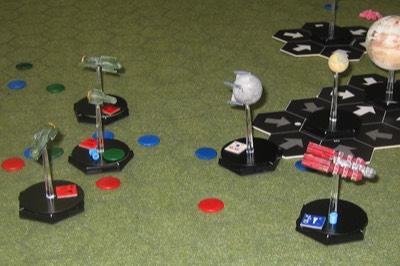
From left to right: three pirate ships (two Corsairs, one Corvette); a Navy Dreadnaught; a Liner/Tanker.
Tanker/liner
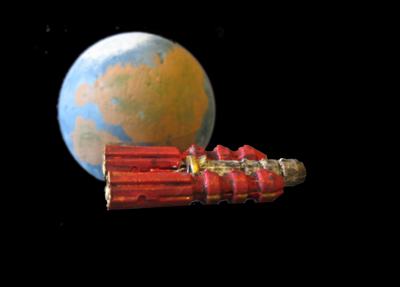
Earth and Liner. The Liner is one short rawl plug, with two at the sides (a rectangle of plastic card runs through the slots in the plugs, to hold them together.
Length of ship: 41 mm.
Length of ship: 41 mm.
Dreadnaught
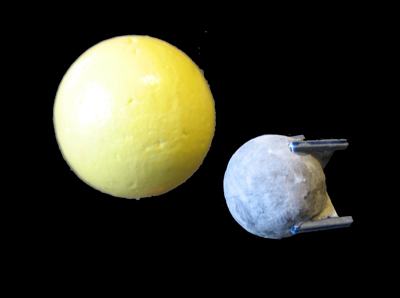
Dreadnaught and Sol. The Dreadnaught was made from a polystyrene ball, with some added pieces of plastic card and plastic rod (H-section). The card fitted into a deep cross, cut into the back of the ball.
Length of ship: 22 mm.
Length of ship: 22 mm.
Frigate
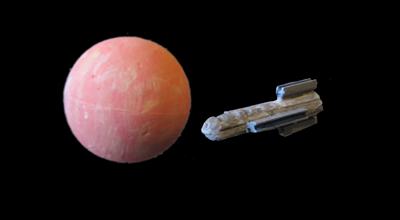
Mars and Frigate. The Frigate is a plastic rawl plug, with added plastic card and H-section plastic rod.
Length of ship: 35 mm.
Length of ship: 35 mm.
Corsair
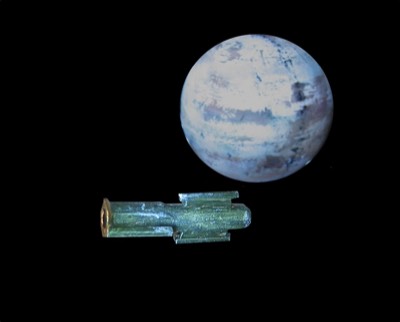
Jupiter and Corsair. The Corsair is a plastic rawl plug, with added plastic card and H-section plastic rod.
Length of ship: 32 mm.
Length of ship: 32 mm.
Corvette
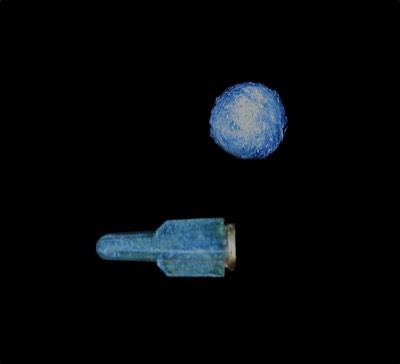
Clandestine and Corvette. The Corvette is a plastic rawl plug, with added plastic card fins.
Length of ship: 22 mm.
Length of ship: 22 mm.
